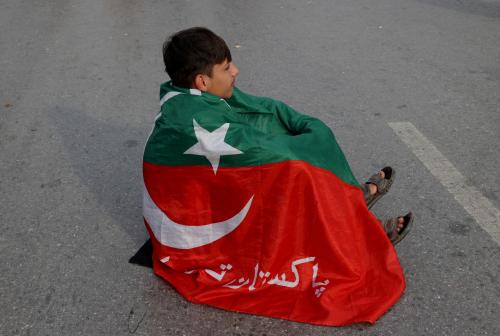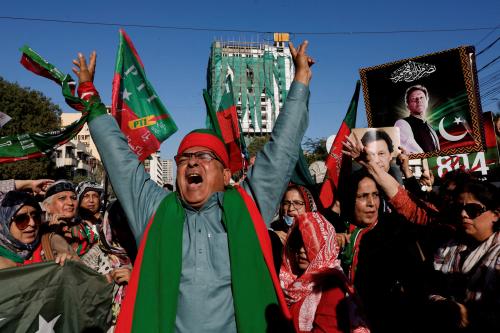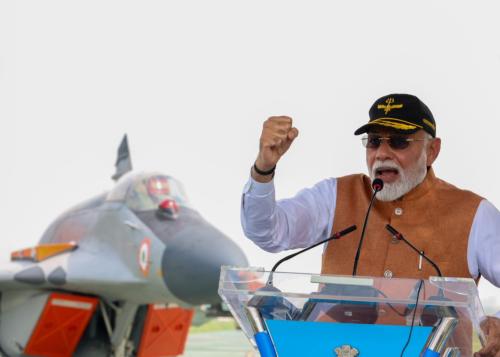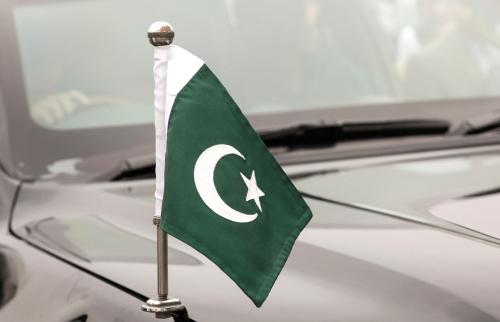On July 15, Pakistan’s government announced plans to ban the country’s main opposition party, the Pakistan Tehreek-e-Insaf (PTI), and begin proceedings of high treason against its leaders, including former Prime Minister Imran Khan. The announcement received immediate and widespread pushback, and it is unclear whether the government, led by the Pakistan Muslim League-Nawaz (PML-N) party, will move forward with the ban, which is unlikely to hold up in the country’s courts. Regardless, the announcement has plainly revealed the new government’s own weakness and deep political insecurity, and that its path forward is uncertain.
The judiciary pushes back on the military establishment
In recent weeks, Pakistan’s courts, which had convicted Khan in a number of cases in the days leading up to the country’s February election, have overturned those convictions. Khan had been sentenced in three cases: on charges of selling state gifts, leaking state secrets, and illegally marrying his wife. The last of those convictions, the illegal marriage case, which had been widely derided by human rights organizations, including the Human Rights Commission of Pakistan, was overturned on July 13.
This personal relief for Khan followed a major legal win for his party, whose official status as a political party had been stripped ahead of the February election, meaning its candidates had to run as independents. Yet the PTI won the largest number of parliamentary seats in the election anyway. On July 12, Pakistan’s Supreme Court restored the PTI to its party status, thereby allowing it to claim its reserved seats in parliament—the additional seats for women and minorities that are proportionally allocated to the number of “general” seats a party wins.
The PTI’s reserved seats had been distributed among the governing coalition parties, meaning the court’s decision has weakened the coalition government while making the PTI the single largest party in parliament. In fact, the coalition government has now lost the two-thirds majority that it needs to make constitutional amendments, effectively shifting the parliamentary balance of power. However, the coalition still has the simple majority it needs to govern.
This rebuke by the judiciary is no coincidence. In the past, Pakistan’s judiciary has frequently been compromised by state pressure, and this year it functioned as an accessory to the military establishment in the run-up to the election. But it has also shown glimpses of independence. A scathing letter written by six judges of the Islamabad High Court to the country’s chief justice in March alleged that Pakistan’s intelligence agencies had been pressuring the judges to rule against Khan’s party. It set up a clear confrontation between the military and the judiciary that has now come to a head.
An unpopular government with a singular focus
Pakistan’s civilian leadership has joined the fray, clearly siding with the military against the judiciary and pushing back on the judicial relief for Khan and the PTI. The government “rearrested” Khan on new charges before he could be released and announced plans to ban his party and initiate treason charges against him. PML-N party leader Nawaz Sharif this week urged the Supreme Court to “rethink” its decision on the PTI’s reserved seats.
It is evident that the government sees Khan as an existential threat and believes that its political survival and future success hinges on eliminating the PTI from the political arena. Khan’s popular support does pose a major political threat to the PML-N: electorally, the two parties compete for the same province, Punjab, the country’s largest. Together with the military, the PML-N government is engaged in a zero-sum confrontation with the PTI. Its energies are consumed by efforts to keep Khan in jail—it has explicitly said that is a goal—and to sideline his party.
Thousands of PTI supporters were arrested after protests last year, some of which turned violent. Many remain behind bars, and some have been subjected to military trials with little transparency. The government has also banned social media platform X for the past five months in an effort to target the PTI’s means of organizing and rallying support.
Yet this is ultimately a losing approach for the civilian government. Its legitimacy has been questioned from the first day of its term, after the election was marred by credible allegations of interference in its favor. It functions as the clear junior partner to the military, which itself faces questions from Pakistanis about its ever-expanding role in the country’s politics and in matters of governance. The military’s and the civilian government’s decisions at this point are indistinguishable; they speak with one voice. But as the senior partner, the military is likely the driving force on most decisions. Their joint attempts to suppress the PTI have proven counterproductive and have only served to make Khan and his party more popular—as seen in February’s election when the PTI won the largest number of seats despite pre-poll and election-day interference.
If anything, the trend has continued after the election: the crackdown irks even those who don’t politically support the PTI. And by making political repression its singular focus, the government has lost sight of its actual job—governing—the means through which it could win back some popular support if it performs well.
Popular resentment
The PML-N has continued to lose popular support since the election, largely due to the country’s tough economic situation and its own policies, which have focused on fulfilling the necessary conditions to sign an agreement with the International Monetary Fund (IMF). The government’s budget—which has been heavily criticized—is tax-heavy; it has focused on increasing taxes on salaried workers while sparing sectors that have traditionally escaped the tax net in Pakistan (real estate, agriculture, etc.).
Energy tariffs have been increased once again this summer, amid heatwaves and on top of successive years of backbreaking inflation. Annual inflation reached an all-time high in Pakistan of nearly 38% in May 2023, when the current ruling coalition was also in power, and came in at 23.4% for the year ending in June 2024. The perception is that the state’s economic burdens are being passed onto its already financially-stretched citizens. The resulting economic mood is increasingly resentful and hopeless.
This layer of widespread discontent comes on top of tensions between citizens in Pakistan’s western provinces, Khyber Pakhtunkhwa and Baluchistan, and the state. In Baluchistan, citizens have been protesting “enforced” disappearances. In Khyber Pakhtunkhwa, there are large, ongoing protests over a recently announced counterterror operation which residents argue will displace them, recalling past military operations.
Losing the West
The Pakistani state is also losing the West due to its political repression and crackdown on the PTI. A United Nations working group this month deemed Khan’s detention to be a violation of international law. After the government’s announcement that it would seek to ban the PTI, the State Department noted that banning a political party would be of “great concern” to the United States. And in June, a U.S. House resolution condemned “attempts to suppress the people of Pakistan’s participation in their democracy, including through harassment, intimidation, violence, arbitrary detention, [or] restrictions on access to the internet and telecommunications.” But this does not seem to have invited introspection: Pakistan’s parliament hit back by denouncing the resolution as “interference” in the country’s internal affairs.
What comes next
The ruling coalition is unlikely to fracture just yet. The PML-N’s coalition partner, the Pakistan People’s Party (PPP), says it will stand by the government and federal cabinet’s decision to ban the PTI. It has also joined the PML-N in asking the Supreme Court to review its decision on reserved seats for the PTI. The PPP’s Asif Ali Zardari is the country’s president, but the party did not join the federal cabinet. PPP has aimed to thread the needle in recent months, paying lip service to criticizing the PML-N while still supporting its decisions. Most important for the civilian government’s survival, the PML-N’s relationship with the military remains strong. The prime minister, Shehbaz Sharif, is the most pro-military leader in Pakistan’s recent history.
However, the political status quo in Pakistan feels increasingly untenable. With the judiciary granting the PTI relief, the current civilian-military leadership has two options. The PML-N government can accept its weaker position and allow the PTI to function as a regular party and the parliament to function democratically. Alternatively, the current leadership can continue to make moves that are antithetical to democracy and continue to slide toward authoritarianism.
The latter seems likely. The government recently dealt a blow to individual freedoms by granting intelligence agencies the legal power to trace and intercept calls. A move to ban the PTI, the country’s largest political party, when the combination of political repression and economic unhappiness has already created deep resentment in the population, could herald civil unrest. Yet the government still announced the plan, betraying its own sense of insecurity and a lack of awareness of the country’s mood. Despite fears of heavy-handedness with protesters, there is a growing sense that the dam could break, with tensions potentially spilling out onto the streets.
There are two fault lines in Pakistan right now: between the civilian-military leadership and the judiciary, and the civilian-military leadership and ordinary citizens. The state’s authoritarian tactics threaten instability on both fronts: they are worth watching closely in the days ahead.
The Brookings Institution is committed to quality, independence, and impact.
We are supported by a diverse array of funders. In line with our values and policies, each Brookings publication represents the sole views of its author(s).







Commentary
In its battle against PTI, Pakistan’s new government exposes its own weakness
July 25, 2024